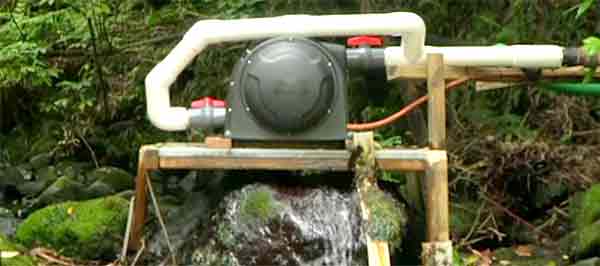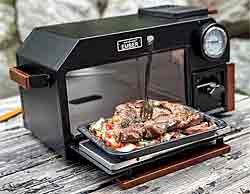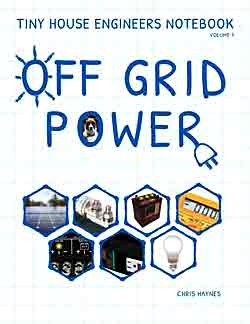Generating Off-Grid Energy
Solar cells are a very popular form of electrical energy generation. We have a whole page dedicated to Solar Power for Tiny Houses. But there are other ways to generate off-grid energy besides photovoltaic solar cells.
Wind Power

Wind power is a good way to generate electrical energy. You’ll notice wind turbines on the masts of many sailboats. These tiny generators charge the battery. There are many sizes of wind turbines for residential off-grid use available today. The only requirement is steady wind.
The 5000 Watt 6 Blade Wind Turbine shown here uses high-power tracking intelligent microprocessor control for effective regulation of current and voltage.
This one sells for $444.69* because it can produce 5000 watts, but there are some in the $150.00* range that produce 400 watts, useful for charging a battery bank. Click on the image to see more details. There are many sizes available. You will also need a mast.
Wind maps will tell you if you have sufficient wind in your area to make the investment feasible. This map measures the wind at 30 meters high so that’s a significant mast.
A wind turbine and solar panels can work together to charge the same set of batteries. This is a great idea for those of use who live in sunny, windy places. I found a great charge controller inverter combo unit that has both wind and solar inputs.
Maglev Wind Turbine
The Maglev Wind Turbine is a new level in wind generator efficiency. Maglev is short for “magnetically levitated”. Using similar technology as a Maglev train, the turbine blades sit on a magnetic cushion providing less friction.
The blades are the newest design in wind capture technology and spin even with a gentle wind.
This Maglev wind turbine generates 400 watts at 24 volts.
It’s available from Amazon for just $279.00* using this link. It’s also available from EBay using this link.
Click here to see a good wind map of the United States so you can determine if wind will be worth the investment for you.
Hydroelectric

If you are lucky enough to have a steady water source on your property with enough volume and vertical drop, you can install a micro-hydroelectric generator.
Shown here is the Pelton turbine PowerSpout PLT, which on a suitable site can produce up to 1.6kW. The cost is $1,919.38* and up.
This model is great for flows with a large head drop and a low flow rate. It is designed to directly charge 12v, 24v, or 48v batteries, or connect directly to a grid-tied inverter. A good choice for off-grid installations where the turbine is within 100ft (30meters) of the battery bank, or a grid-tied installation where the turbine is less than 2000ft away from inverter location. If off-grid, turbine will require a load dump charge controller to protect the battery bank. This turbine can reach power output of up to 1500 watts.
These generators produce a loud whine, so a sound box would need to be constructed. You will also face maintenance, air-locks, and freezing issues. This is just part of being off-grid.
While expensive in the beginning, hydroelectric power can be a lower-cost alternative in the long run over photovoltaic solar panels and more reliable than wind power.
If you are up for an engineering challenge, you can get parts and create your own generator. E-Bay is a good source of micro-hydro generation parts.
Here’s a great blog about homestead with hydro electric power.
Electric Generators
Electric generators, sometimes referred to as “backup” generators, run on gasoline or propane. Off-grid enthusiasts use these as little as possible because they burn fossil fuels. A generator is used when the other energy sources aren’t quite enough.
Pure Sine Wave Inverter Generators I Recommend
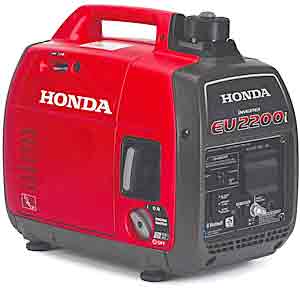
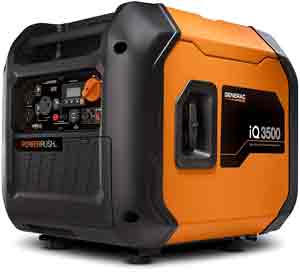
The Generac 7127 produces 3500 watts of pure sine wave power and claims to be 40% quieter than the Honda. Generac produces more power for the dollar and has a more flexible assortment of outlets including USB. It’s currently listed on Amazon for $1,199.00*. It weighs 109 lbs.
The Honda EU-2200i, shown here, produces 2200 watts. It weights just 54 lbs. and has a built-in carbon monoxide detector that will shut it off if it gets too high. It currently sells for as-low-as $1,199.00* on Amazon.
Compare the top Portable Inverter/Generators on this page.
Here’s another page you be interested in: Generators or Portable Power Centers: Which is Right For You?
If you already have a generator you might need the tips on this page: How To Quiet Down You Generator.
Portable Power Centers
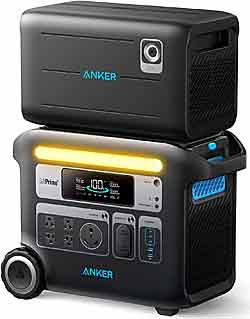
Portable power centers, sometimes called solar generators, are basically large batteries built into the same box with a charge controller and a nice pure sine wave inverter.
Now featuring LiFePO4, LFP batteries with 3000 charge cycles and fast charging, these power centers are a viable means of powering your off-grid homestead.
The Anker, 767 (now called the Solix F2000), shown here with the expansion battery, holds 2048 Wh of power for just $2799.00*. Anker has matching solar panels, so you can be confident you are getting the proper compatible equipment.
Jump to our page that show details of portable power centers: Portable Power Centers How To Choose
Also see this page to gather details of generators compared to portable power centers: Generators or Portable Power Centers: Which One is Right for You?
Subscribe to our newsletter to be notified of coupon codes like this: $300.00* off Anker products with the code TINYLIFE.
Off-Grid Energy Storage Bank
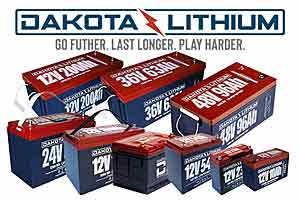
Any off-grid power system will require a battery storage bank. This will be the most expensive part of the system.
Lithium-ion batteries are expensive, but last for many more charge cycles, allow the use of more of the charge, and maintain their full charge capability for a longer period of time than most other types of batteries.
Dakota Lithium has an expansive line of tough lithium/Ion batteries.
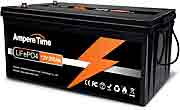
This Li Time Lithium/Iron Phosphate Deep Cycle battery is a great value. This battery provides 2000~5000 cycles (10 times longer) & a 10-year lifetime compared to 300~500 cycles and a 3-year lifetime in lead/acid battery. It weighs only 46 lbs, which is about a third of lead/acid. They produce their optimal power over 90% of their charge cycle as opposed to lead/acid batteries which are about 50%. $479.99*. Click on image to learn more.
More battery information is available on this page of Tiny Life Consulting.

Propane
Seeing a large propane tank in someone’s yard is very common in rural areas. The propane company delivers a tank, and contracts with you to refill the tank either periodically or when you call. People frequently call to refill their tanks in the spring when the prices are lower.
Some purists may not consider propane to be off-grid, because basically you’re inviting the utility’s delivery truck onto your property. I think propane is a very useful tool, so why not use it? While most of my friends heat with wood, several appliances run on gas: the cook stove, oven, water heater, and central heater. Even the generator runs on propane to charge the batteries when there’s no sun.
You do need to be aware of carbon monoxide poisoning and the possibility of leaks.
In super-cold weather, the smelly additive can get slushy and clog the regulator so a tank heater might be necessary. But all things considered, when you are heating, gas is less expensive than electric.
Other forms of off-grid energy generation
We looked into all types of electrical generation, including pedal power. Tiny homes really don’t have room for a stationary bike with a generator attached, and the power generated is very small.
But there are other places to get energy that should not be overlooked.
Your car generates power
Set up a charging station in your vehicle so you can charge all of your batteries while driving into town for supplies.
Biogas Off-Grid Energy Source
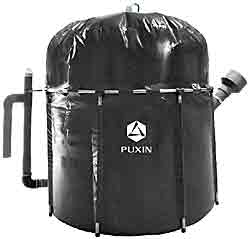
Biogas is the use of naturally-produced methane coming from the decomposition of organic waste. Food scraps, sewage, and animal manure are forms of organic waste. About 50-70% of the gas produced is flammable and can be used as an off-grid energy source.
Please note that the only appliance you can run off of this energy source is the biogas stove included in this kit.
A digester bag, shown here, is required for the biogas process. Average outside temperature must be above 68° F. It requires constant maintenance. This digester bag from Home Biogas includes a 1 burner stove for $680.00*.
PUXIN Lightweight Flexible Household Biogas Plant is composed of a membrane digester bag combined with a gas storage bag, a support frame to support the digester bag, an outlet for flowing out the slurry, a biogas filter, and a biogas pump to supply the pressure for the biogas stove.
Geothermal heating and cooling
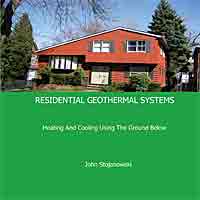
My uncle has a stream behind his house. He pumps the water through a heat exchanger in the air conditioner. It cools the house nicely. The water is then pumped onto the lawn. The hotter it gets, the greener his grass is.
I live in the geothermal hotspot of Pagosa Springs, Colorado. Besides having a hot springs resort, the town heats a portion of the central downtown core with hot water from the springs.
Even if you are not lucky enough to live in a geothermally active area, you can still harness the energy of the earth.
From Residential Geothermal Systems:
“Interest in residential geothermal systems has grown as more people realize they can replace their fossil-fuel heating system with one that is three to five times more efficient and doesn’t require a chimney to exhaust noxious fumes.
Currently in the USA there is a federal 30% tax credit* that applies to the total installation cost. These newer, safer systems provide heating as well as cooling simply by transferring heat between the home and the ground or a nearby body of water.
Since this is a relatively new technology, the number of experienced installers is limited, but growing. Therefore, there is a burden on homeowners interested in installing one of these systems to absorb as much information about residential geothermal systems as possible. This book was written specifically to meet that need as well as to help HVAC professionals who are new to residential geothermal systems.” Click on image to order.
Using your wood stove more efficiently
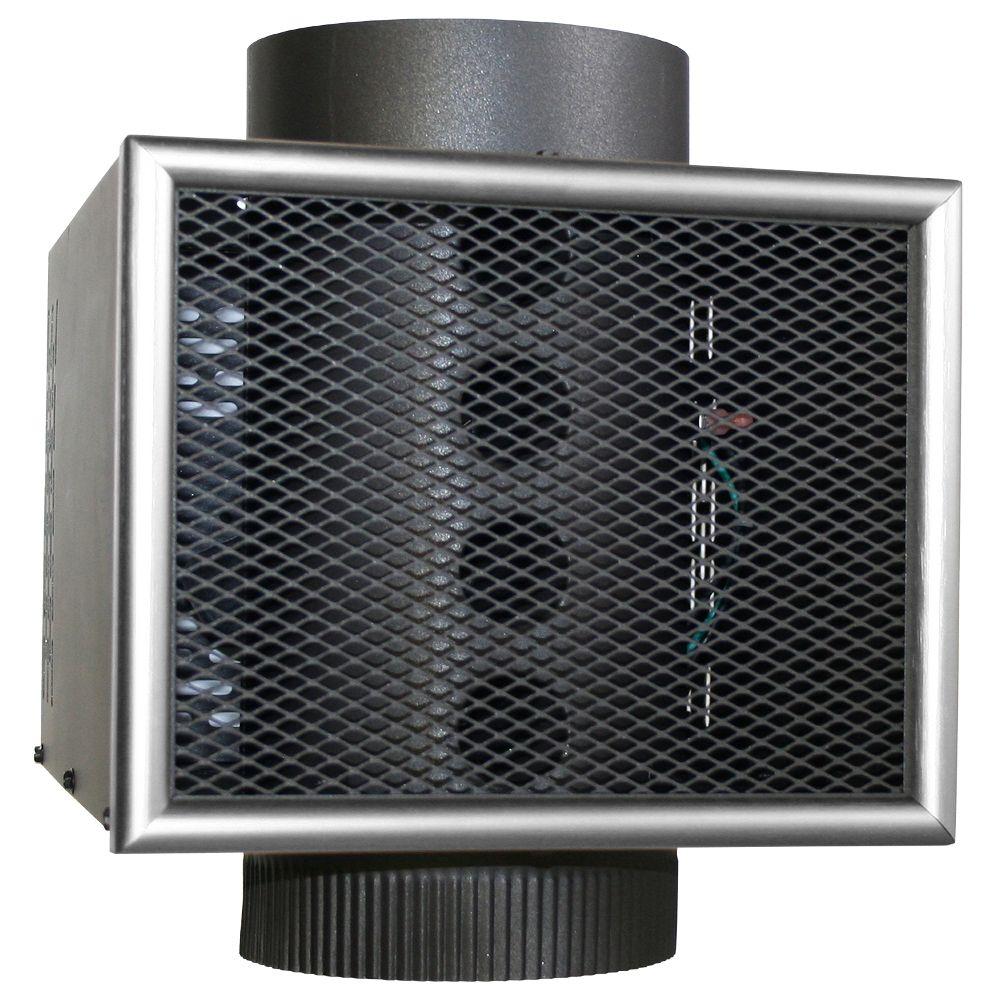
Wood stoves have been heating homes and cooking food forever. However, most of the heat is wasted going straight up the chimney. Here is an addition to any wood stove to make it more efficient: the US Stove Miracle Heat Blower. Compatible with wood or coal stoves and furnaces, it’s designed to improve the efficiency of an older stove or furnace. This blower features an integrated thermo disk that senses the heat in the chimney and once hot, blows air through the heat exchanger to bring up to an extra 10% of the heat loss back into the room. Easy to install into a 12 in. section of the stove pipe just above your stove, this blower is ultra-quiet and has fully automatic operation.
This is a helpful device to add heat to a second floor or loft.
Pedal Power
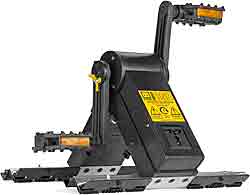
Everybody asks so I’ll include it. Pedal power does produce energy, but it is very inefficient.
This pedal generator can charge a 12 volt car battery at the rate of .8 amps. My research shows it would take more than 500 hours of pedaling to recharge an average car battery.
The K-TOR, Power Box 20 Watt Pedal Generator includes the 12 volt generator for $224.95*.
The style that uses your bike on a stationary stand to run the generator is $1,495.00*. It can charge a 12 volt battery at the rate of .5 amps. Voltage on these things varies all over the place from zero to 80 volts depending on how hard you are pedaling. The car battery is used a a regulator.
Thermoelectric Generators
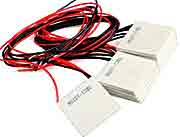 Peltier Thermoelectric Cooler Module
Peltier Thermoelectric Cooler Module
A Peltier module produces electricity when there is a difference in temperature between one side and the other. The greater the temperature difference the more power they produce. In any case the amount of electricity produces is very small but several uses for these have been devised.
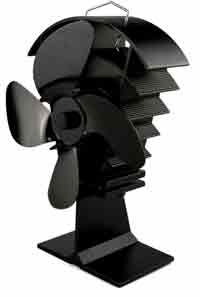
Heat Powered Fans
This same technology is used in those neat fans you see on a wood stove. There’s a Peltier module sandwiched between the base of the fan and the large heatsink.
This small wood stove fan is a perfect addition to every home that has a wood stove. No batteries or electricity required, but simply the heat from your stovetop, this Eco-friendly fan allows you to get the maximum heat from your wood burner stoves. There are dozens of designs. Click on image to see them on Amazon.
BioLite CampStove 2+ Wood Burning, Electricity Generating & USB Charging Camp Stove
Turn fire into electricity with BioLite’s CampStove 2+. Patented combustion technology creates a vortex of smokeless flames for a portable campfire that can cook your meals and charge your devices. CampStove 2+ generates 3 watts of power.
Charge and cook at the same time or store power in the 3,200 mAh battery for later use. The light and super-packable wood burning stove covers all the bases including camping, backpacking, and emergency situations like losing power. Not a bad idea.
CampStove packs down the size of a 32-ounce wide-mouth water bottle (5 x 8 inches) and weighs 2.06 pounds; includes a 100 lumen LED FlexLight to light surroundings, stuff sack, fire starter, and USB cord.
Another Thermoelectric Generator
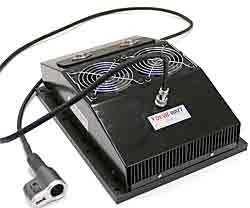
TEGMART produces thermoelectric generators for woodstoves as well as propane stoves and candles. They use the same Peltier component.
The DW-SM-45W Wood Burning Stove Thermoelectric Generator can be placed on the top or mounted onto the side wall of a stove to generate electricity to charge a battery, power a 12V DC device, or charge a cell phone with it’s handy USB charging port. The DW-SM-45W is supplied with 2 cables: one for charging a battery, the other supplies a 12V DC automotive output and a 5V DC USB port.
To ensure an adequate temperature difference necessary for power generation, the low temperature side of the Thermoelectric Generator is cooled with 2 electric fans that help circulate heat in the room with up to 120 CFMs of air movement. This unit is lightweight and provides a lot of output power for it’s size.
Their largest generator is 100 watts and requires water cooling. They devised an entire tiny home hydronic heating system using the hot water from the generator.
These devices are very expensive for the small amount of electricity they produce.
Ember Off-Grid Biomass Oven
The InstaFire, Ember Off-Grid Biomass Oven lets you bake safely indoors and outdoors completely off-grid – all you need is BIOMASS (like sticks, twigs & leaves). That means you can enjoy hot meals wherever and whenever you want without securing traditional fuels. Instead, trust mother nature to power your Ember and keep you fed.
Paired with its TRANSPORTABLE and EASY-TO-USE design, the Ember is a game changer for emergencies and outdoor excursions alike.
The Ember Oven can also use charcoal briquettes and canned heat as fuel.
More Pages on this website with information you’ll find useful
Generators or Portable Power Centers. Which is right for you?
Portable Power Centers How To Choose
How to quiet down your generator
Solar power for your tiny home
Off-Grid Solar System Components
Running Appliances like air-conditioners off-grid.
Best ways to heat your tiny home
For great books on off-grid and DIY energy production, visit the Tiny Life Consulting bookstore: The Best Tiny House Bookstore


